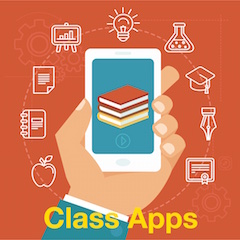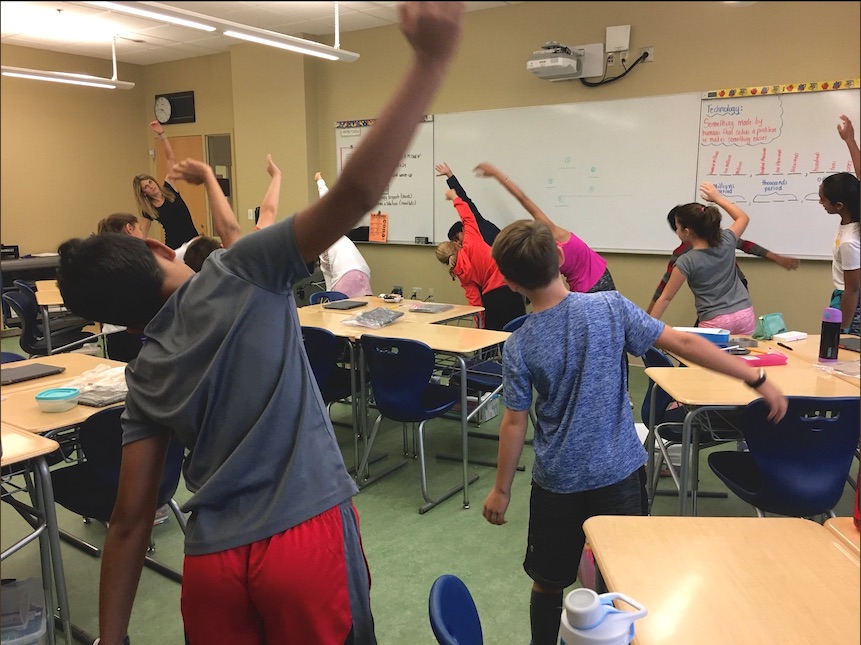Students Learn Better When They’re Moving
A MiddleWeb Blog
 My Teaching Secret
My Teaching Secret
I have a teaching secret. Not the good type, like a trick or tip to make sure every lesson is a success…but the kind I’m NOT proud of. Here it is:
Despite all the writing and speaking I do about making learning student-focused, participatory, and engaging, deep down what I really crave is a compliant, calm, predictable classroom. The truth is that I feel the most comfortable in the driver’s seat of learning – with my students securely fastened and buckled up in the back.
That’s probably why I spent much of my rookie teaching year trying to get students to sit still and be quiet. On the rare occasion this was achieved, I erroneously interpreted it as evidence of learning.
Over the years, however, my eyes have been opened to the need for a more energetic, kinesthetic experience for our students. The research confirms it and many teachers sense it – even if we might wish otherwise.
What we’re discovering about movement and middle grades learning
When working with young adolescents, some of the most powerful – and long-lasting – learning takes place when our students are intellectually, socially, and physically engaged (Edwards, 2015). The importance of the first two elements – intellectual and social engagement – is widely accepted and applied in classrooms.
Engaging students physically, however, often receives far less attention. This is unfortunate considering the following:
- The body plays an integral part in all our thinking, learning, and intellectual processes. Our entire brain structure is intimately connected to and shaped by the movement mechanisms within our body (Hannaford, 2013).
- Movement and physical activity in the classroom are linked to improvements in cognitive function (e.g., attention, memory), academic behaviors (e.g., homework completion, time on task), and academic achievement (Warehime et al., 2019).
- Active learning strategies (games, experiential learning, manipulatives, experiments, building models, and hands-on projects) consistently engage middle level students, including those most in need of academic support, such as students with cognitive impairments or learning disabilities (Erwin, Fedewa, & Ahn, 2017; Nesin, 2012).
- Even brief uses of physical activity improve students on-task behavior and academic performance in areas such as mathematics and reading (Kibbe et al., 2011).
- Classrooms that ask students to do rather than just listen foster on-task behavior, increased collaboration, increased self-confidence, greater risk-taking, and additional opportunities for leadership roles (McGlynn & Kozlowski, 2017).
- Bringing physical movement into the classroom and connecting it directly to what is being learned helps students better experience the curriculum and make deeper emotional, interpersonal, and kinesthetic connections to academic subjects (Gris, 2016).
When exactly should we incorporate movement in our lessons?
Despite our knowledge – and a growing body of research – regarding the crucial connection between physical engagement and student learning, educators often find it challenging to develop kinesthetic learning activities.
When trying to determine whether or not to incorporate movement into the classroom, it’s wise to consider the following questions.
- Does this concept, learning goal, and/or skill lend itself to physical movement?
- Would a kinesthetic activity enhance students’ engagement and/or their understanding and recall of this concept/skill?
- Are the routines of my classroom strong enough to include movement? If not, what do I need to do to strengthen my classroom routines?
- How much time should be allocated to the movement part of the learning activity?
- What will I need to model/monitor to help students be successful?
In reality, not every concept or skill we are trying to help students develop needs to be tied to movement. A particular lesson or learning goal might not be the best fit. Or we might be short on time. As often as possible, however, teachers should try to tap into students’ natural desire to fidget and squirm.
Here’s an example I captured on video during a classroom visit. It’s one of the liveliest vocabulary activities you’re likely to see, as students turn their Word Wall into a “song and dance” routine. (Two students also talk about why they like it.)
Strategies (including tech) that get kids moving and learning
In Classroom Instruction that Works, Dean and Hubbell (2012) suggest a few teaching strategies that can be used by educators in virtually every setting to help students to create, store, deepen understanding of information. They include:
- Engaging in kinesthetic activity: Students engage in physical movement associated with specific knowledge to generate a mental image of content and skills being learned.
- Creating pictures, illustrations, and pictographs: Students draw, paint, or use technology to create symbolic pictures that represent knowledge being learned.
- Making physical models/manipulatives: Students are involved in hands-on tasks to create concrete representations of knowledge.
In addition, as I’ve visited the classrooms of other teachers, I’ve compiled an informal list of other kinesthetic learning strategies and technology tools that set learning ‘in motion’ without devolving into classroom chaos.
- Working with students to develop vocabulary review songs (see video above) that incorporate motions and actions
- Teaching students ‘arm actions’ that help make similar sounding concepts distinct from one another
- Using sites like GoNoodle and MovetoLearn between lesson components that encourage students to take regular ‘stand, stretch, and move’ breaks
- Allowing students the option of standing or moving while working independently to create a more ‘fidget friendly’ learning environment
- Standing up while doing a think-pair-share
- Encouraging students to play vocabulary charades by acting out key concepts
- Having students participate in or create short, silly skits that encourage students to demonstrate understanding of important terms
- Designing gallery walks that encourage students to move around the room in small groups and answer/discuss discussion questions and complete mini-activities in an allotted amount of times
- Human data activities that ask students to move to/stand in a particular area inside or outside the classroom based on their answer to/level of agreement with a statement.
- Asking students to work in teams to develop silent skits that illustrate a process (how a bill becomes a law, the water cycle, etc.)
- If funding is available, organizing scavenger hunts using BreakoutEDU and GooseChase that encourage teams of students to compete to find items assigned by the teacher around the school/classroom… then take/post photo evidence at each point
- Modifying word games such as Taboo, Catch Phrase, and Pyramid to help students discuss and review terms
- Using tools such as GoogleSlides, Google Drawings, Infogram, and Visme to have students design icons that illustrate what is being learned
- Encouraging students to create and share infopics that illustrate important terms/concepts
Ready? Set? Move!
Effective teaching and learning in a middle school means engaging students intellectually, socially, and – perhaps most important – physically. Educators who work strategically to incorporate elements of physicality will have students who are attentive, focused, making connections, and able to recall information later on.
We all want our students to learn and be successful. Our students all want the opportunity to move around. Why not work strategically to build participator, kinesthetic activities that encourage them to do both? If you have questions or want to share ideas, please do that in the comments!




































Your vocabulary exercise is impressive and fun! The 6-Trait Writing Program has a series of arm movements describing each trait of writing. Kids memorized and we would do it daily. That was fun, too!
This reminded us of the 6 Traits songs, which include hand movements in this version. Note the “modern” musical versions included here (from 2011 – smile). The kids are definitely in motion!
Love it. What a fun way to help them remember so many different key elements.